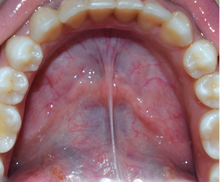Floor of the mouth
The floor of the mouth (Latin: diaphragma oris ) is the entirety of the soft tissues between the lower jaw body ( corpus mandibulae ) and hyoid bone ( os hyoideum ) and forms the caudal closure of the oral cavity .
From top to bottom a layer of mucous membrane ( multi-layered, uncornified squamous epithelium ) is found with the characteristic relief formed by the plica sublingualis , caruncula sublingualis and the frenulum of the tongue . Below is the sublingual gland ( sublingual gland ).
This is followed by the genioglossus muscle (which is basically assigned to the tongue muscles ) and the muscles of the floor of the mouth in the narrower sense, namely the geniohyoideus and mylohyoideus muscles , which stretch a closed muscle plate between the lower edge of the lower jaw and the hyoid bone. In addition, the front abdomen (venter anterior) of the digastric muscle serves as an external reinforcement.
Individual evidence
- ^ Lehmann, Klaus M., Elmar Hellwig: Zahnärztliche Propädeutik . 10th edition. Urban & Fischer at Elsevier, 2005, ISBN 3-437-05391-4 , p. 6 .
- ^ Hoffmann-La Roche AG and Urban & Schwarzenberg (eds.): Roche Lexicon Medicine . 2. rework. Edition. Urban & Schwarzenberg, Munich, Vienna, Baltimore 1987, ISBN 3-541-11212-3 , pp. 1166 .
